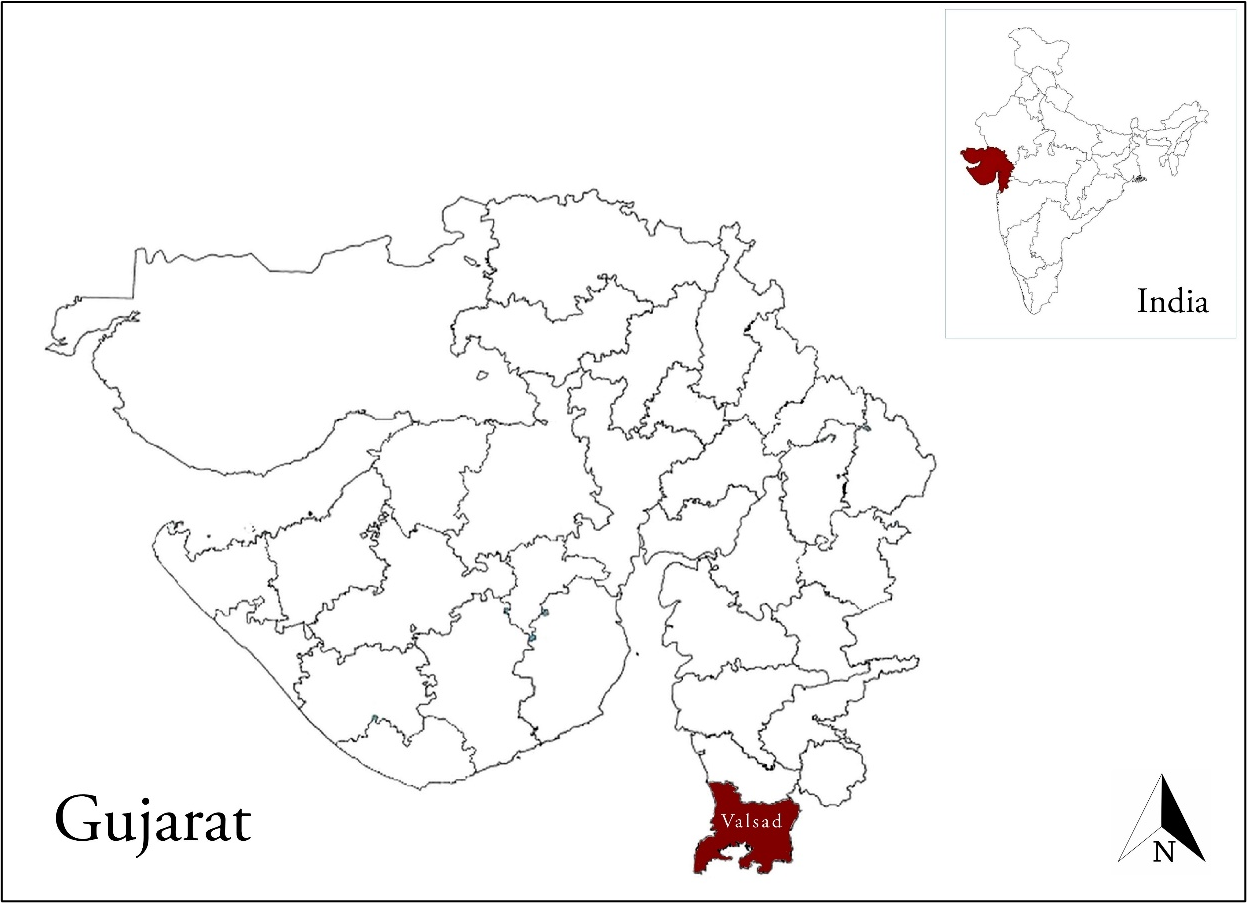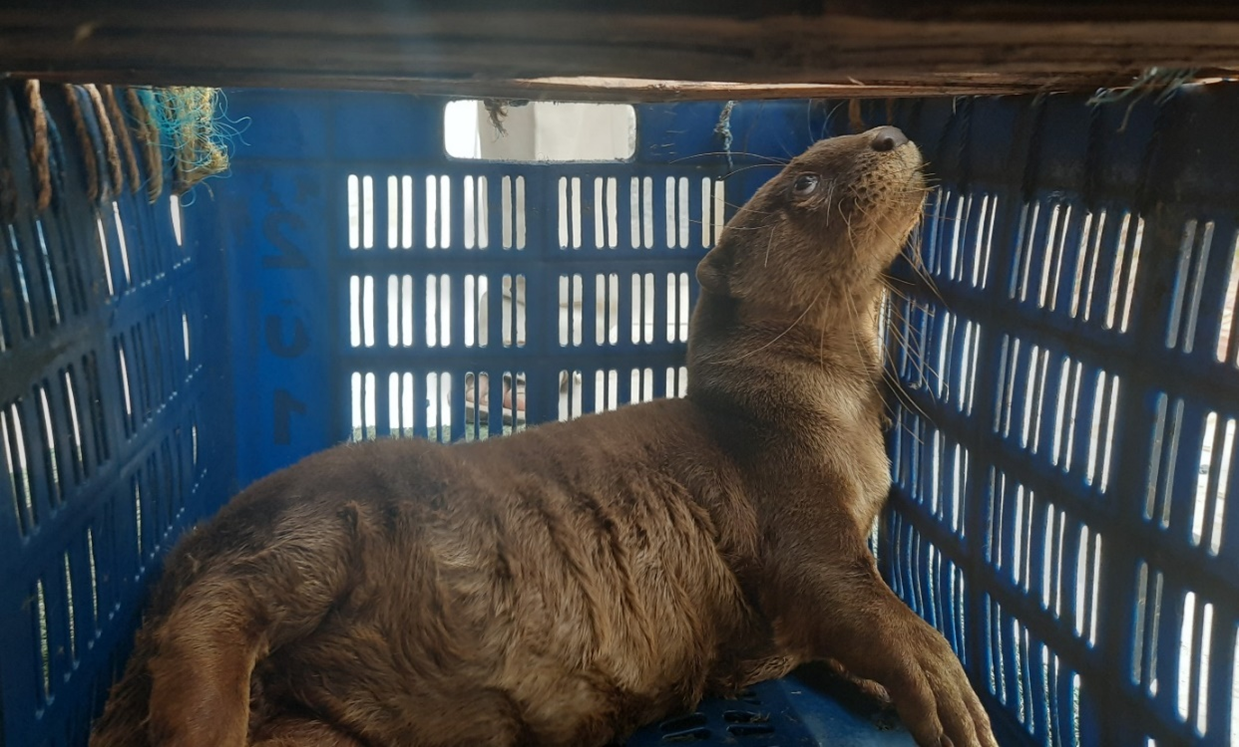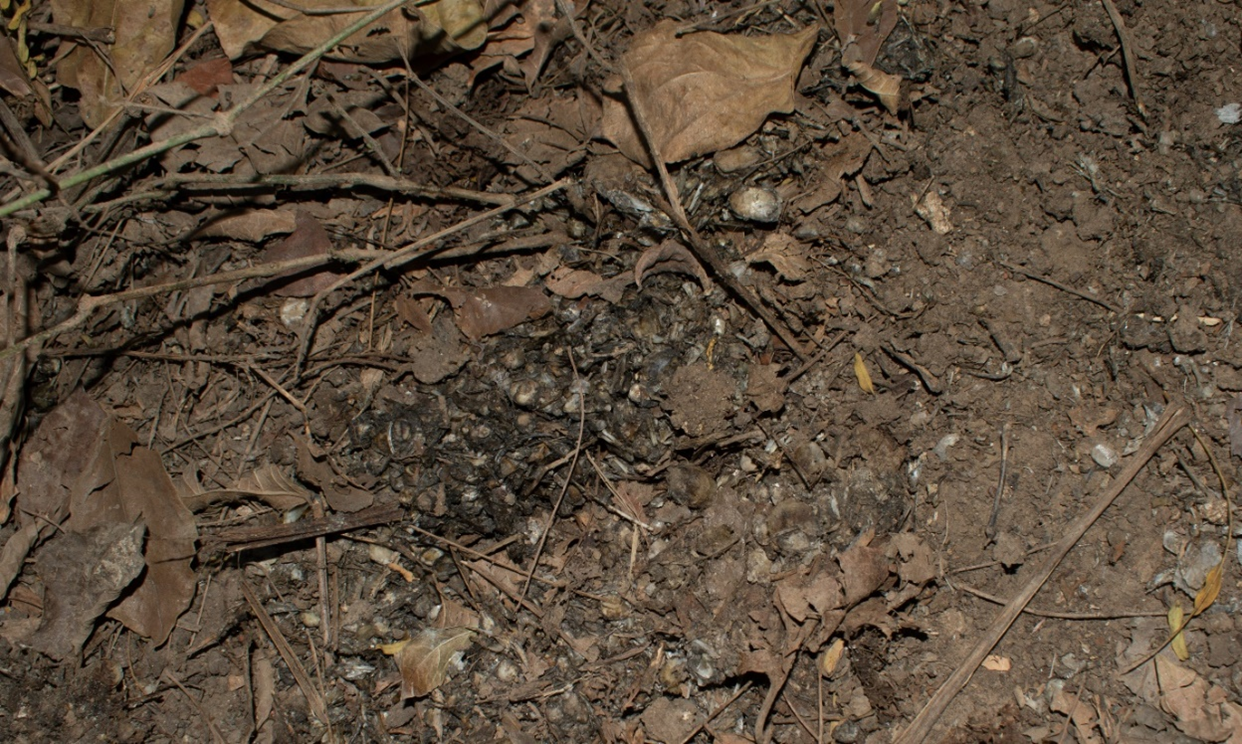IUCN/SSC Otter Specialist Group Bulletin

©IUCN/SCC Otter Specialist Group
Volume 39 Issue 4 (November 2022)
Citation: Trivadi, K., and Patel, A. (2022). Smooth-Coated Otter Distribution and Report on Illegal Otter Trafficking in Valsad, India IUCN Otter Spec. Group Bull. 39 (4): 196 - 201
Smooth-Coated Otter Distribution and Report on Illegal Otter Trafficking in Valsad, India
Krunal Trivedi1, and Aadit Patel2
1Nature Club Surat, 81, Sarjan Society, Parle Point, Surat, Gujarat, India
2At & Post Kundi (Haji Talav), Dungri, Valsad, Gujarat, India
*Corresponding Author Email: krunal.trivedi.7567@gmail.com
(Received 24th March 2022, accepted 2nd May 2022)
Abstract: In India, three species of otter are found, but only the Smooth-coated otter Lutrogale perspicillata has been reported in Gujarat. Current distribution of this species is limited to Surat, Bharuch, Narmada, and Vadodara District. Hereby, we present distribution of smooth-coated otter in Valsad District. Direct sighting, and indirect sign surveys were the methods used for this study. This might be the southernmost distribution of this species in Gujarat. We also report seizure of sub-adult female otter from illegal trafficking in Valsad. There is a need for further extensive research on the status, distribution, and habitat-use pattern of otters in South Gujarat.
Keywords:Smooth-coated otter, distribution, conflict, Otter trafficking, Otter trade, Gujarat.
INTRODUCTION
Otters are a suitable indicator species for a healthy riverine ecology since they are aquatic predators at the top of the food chain (Kruuk, 1995). They're known to live in a semi-aquatic environment. India is home of three species of otters, Smooth-coated otter (Lutrogale perspicillata), Small clawed otter (Aonyx cinereus), and Eurasian otters (Lutra lutra) (Reuther, 1999). Smooth-coated otter is widely distributed across Southeast Asia. Recent studies stated current distribution of Smooth-coated otter in Bharuch, Vadodara, Narmada, and Surat District of Gujarat (Suthar et al., 2017; Trivedi and Joshi, 2018; Nagrecha and Suthar, 2019). Rivers such as Narmada, Tapi, Purna, and Mahi, among others, have been proven to be lifelines for otters in Gujarat. Otter population is facing threats because of degradation, riparian habitat loss, poaching, and disturbance by human activities, and their feeding behaviour brings those direct conflicts with fisherman who saw otter competitor for fishing (Raj, 1941).
TRAFFIC, in collaboration with the IUCN-SSC-OSG, analysed otter seizures throughout Asia between 1980 and 2015 to better understand the scope of the illegal trade and the species affected. That study, hereinafter referred to as the “otter seizure analysis”, found that tropical Asian otters were involved in illegal trafficking, with 161 otter seizures reported across 15 nations, involving an estimated 5881 people (Gomez et al., 2016). The Smooth-coated Otter is particularly popular among poachers for its pelt and meat (Gomez et al., 2016). Poaching for pelt and meat worsens the adverse effects that these threats have on wild populations. As a result, they are surviving in fragmented population in some isolated areas. In India, Smooth-coated otters are protected under schedule II of the Wild Life (Protection) Act, 1972. It has been assessed as “Vulnerable” by IUCN Red List of Threatened species and listed in Appendix I of CITES (de Silva et al., 2015). Current study provides information on distribution of otter in Valsad District on the basis of sign survey and direct sightings. We also report seizure of otter from illegal trade. The entire study was conducted between June 2020 and March 2022. During this study we also identified potential threats to otter populations.
STUDY AREA
Valsad district is located on the shore of the Arabian Sea (Fig. 1). It has a tropical savanna climate with little to no rainfall from October to May and very heavy to extremely heavy rainfall from June to September when it is under the direct influence of the Arabian Sea branch of the South-west monsoon. The average elevation of the town is 13 meters (43 feet) above the sea level.
OBSERVATIONS
On 2nd June 2020, Valsad Forest Department confiscated a sub adult female smooth-coated otter (Fig. 2) from animal trafficking racket from Nanapondha village of Valsad District and arrested five accused during the raid. An official case was filed against the accused by Valsad Forest Department under various sections of Wildlife Protection Act 1972. As per the information, the otter was caught from Doldha river, near Amadha Village and kept at house of one of the accused. It was believed that accused tried to sell the otter on domestic level within Gujarat for pelt and meat trade or for superstitious activity. No actual reason for the trafficking was confirmed during the investigation. Later on, the otter was released under supervision of forest officials in its suitable habitat. On further investigation, we found tracks and signs of more otters in Amadha village. On 18th April 2022, all the accused got convicted with three years imprisonment and ten thousand rupee penalty.
In addition to this, we report otters from four other sites in Valsad District (Table 1). The presence of otters was confirmed by direct sighting (Fig. 3) and indirect evidence such as tracks and spraints at the sites (Fig. 4). This is the first photographic record of smooth-coated otter from Valsad District. This may be the southernmost current distribution of this species in Gujarat.
In Gundlav village, we observed a pair of otters in a lake. We found an active den in the nearby area where the otter grooming signs and spraints were found. The sighting was occasional but continued for more than three months at the same village. We also found a pair of otter in Kundi village. During the observation, we found them hunting in the water body and grooming on the sand bank in the nearby area. No den was reported from this village but the area has dense vegetation and there is a possibility that the otter uses this dense vegetation as a shelter.
In Gundlav village, we observed a pair of otters in a lake. We found an active den in the nearby area where the otter grooming signs and spraints were found. The sighting was occasional but continued for more than three months at the same village. We also found a pair of otter in Kundi village (Fig. 3). During the observation, we found them hunting in the water body and grooming on the sand bank in the nearby area. No den was reported from this village, but the area has dense vegetation and there is a possibility that the otter uses this dense vegetation as a shelter.
During the study, various threats to otters were observed, including poaching, fish poisoning, intensive fishing, habitat damage, etc. These threats can be a serious concern for otter population in this fragmented area. There is a serious need of further extensive research on the status, distribution, potential threats, and habitat-use pattern of otters in South Gujarat.
To ensure the species' long-term survival in South Gujarat, habitat protection, reducing threats, raising public awareness, and incorporating the local population in otter conservation is essential.
Acknowledgements: We would like to express our gratitude to Abhijeetsinh Rathod Range Forest officer of Nanapondha, Kaprada Range, Mr Raj Bhavsar of GSPCA and Wildlife SOS, and Valsad Forest Department for providing necessary information about the confiscated otter from Nana Pondha. We would like to thank Mr. Snehal Patel, Mr. Ashish Vakil from Nature Club Surat, Mr. Puneet Nayyar (IFS) from Gujarat Forest Department, and Nature Club Surat for their continuous support.
REFERENCES
de Silva, P., Khan, W.A., Kanchanasaka, B., Reza Lubis, I., Feeroz, M.M. and Al-Sheikhly, O.F. (2015). Lutrogale perspicillata. The IUCN Red List of Threatened Species 2015, e. T12427A21934884, https://dx.doi.org/10.2305/IUCN.UK.2015-2.RLTS.T12427A21934884.en
Gomez, L., Leupen, B T.C., Theng, M., Fernandez, K., and Savage, M. (2016). Illegal Otter Trade: An analysis of seizures in selected Asian countries (1980-2015). TRAFFIC. Petaling Jaya, Selangor, Malaysia. https://www.traffic.org/publications/reports/illegal-otter-trade/
Kruuk, H. (1995). Wild otters - Predation and Populations. Oxford University Press.
Nagrecha, P.G., Suthar, A.R. (2019). First photograph of smooth-coated otter in Mahi River, Gujarat, India. OTTER, Journal of the International Otter Survival Fund, 5: 14-19. https://www.otter.org/documents/journals/IOSF_Journal_Vol5_2019.pdf
Raj, B.S. (1941). Dams and fisheries: Mettur and its lessons for India. Proceedings of the Indian Academics of Science,14: 341-358. https://doi.org/10.1007/BF03051147
Reuther, C. (1999). Development of weight and length of Eurasian otter (Lutra lutra) cubs. IUCN Otter Spec. Group Bull. 16: 11-26. https://www.iucnosgbull.org/Volume16/Reuther_1999.html
Suthar, A.R., Rathod, J.Y., Patel, I.B., Gavali, D.J., Lakhmapurkar, J. (2017). Historical and current distribution of smooth-coated otter Lutrogale perspicillata in Gujarat, India. IUCN Otter Spec. Group Bull. 34: 95-103. https://www.iucnosgbull.org/Volume34/Suthar_et_al_2017.html
Trivedi, K., Joshi, P. (2018). Photographic documentation and distribution of smooth-coated otter (Lutrogale perspicillata) (Geoffroy 1826) in Surat, Gujarat. IUCN Otter Spec. Group Bull. 35: 31-36. https://www.iucnosgbull.org/Volume35/Trivedi_Joshi_2018.html
Résumé: Distribution de la Loutre à Pelage Lisse et Rapport sur le Trafic Illégal de Loutre à Valsad, en Inde
En Inde, on trouve trois espèces de loutres, mais seule la loutre à pelage lisse Lutrogale perspicillata a été signalée au Gujarat. La distribution actuelle de cette espèce est limitée à Surat, Bharuch, Narmada et au district de Vadodara. Dans cet article, nous présentons la répartition de la loutre à pelage lisse dans le district de Valsad. L'observation directe et les relevés d’indices de présence constituent les méthodes utilisées dans le cadre de cette étude. Ce pourrait être la distribution la plus méridionale de cette espèce au Gujarat. Nous signalons également la saisie de loutres femelles subadultes issues du trafic illégal à Valsad. Il est indispensable de poursuivre des recherches approfondies sur le statut, la distribution et le modèle d'utilisation de l'habitat des loutres dans le sud du Gujarat.
Revenez au dessus
Resumen: Distribución de la Nutria Lisa, e Informe sobre el Tráfico Ilegal de Nutrias en Valsa, India
La nutria lisa Lutrogale perspicillata es una de las tres especies de nutria que viven en Nepal. Se cree que fue extirpadEn India se encuentran tres especies de nutria, pero en Gujarat se ha reportado solamente la nutria lisa Lutrogale perspicillata. La distribución actual de la especie se limita a los distritos de Surat, Bharuch, Narmada, y Vadodara. Aquí, presentamos la distribución de la nutria lisa en el Distrito de Valsad. Los métodos utilizados para éste estudio fueron el avistaje directo, y relevamientos indirectos de signos. Ésta podría ser la distribución más austral de ésta especie en Gujarat. También informamos el decomiso de una nutria hembra sub-adulta, del tráfico ilegal en Valsad. Es necesaria una extensiva investigación sobre el status, distribución y patrón de uso de hábitat de las nutrias en Gujarat del Sur.
Vuelva a la tapa





